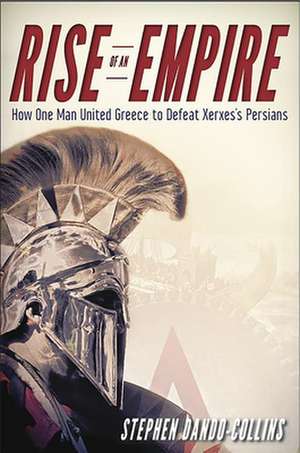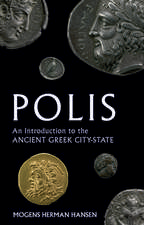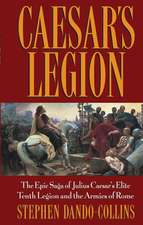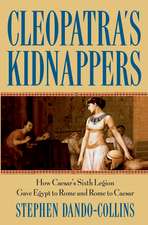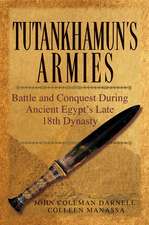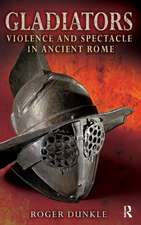Rise of an Empire
Autor Stephen Dando-Collinsen Limba Engleză Paperback – 9 iul 2013
The true story behind the events in 300: Rise of an Empire, the sequel to Zack Snyder's 300 The action-filled movie 300 focused on Ancient Greece's epic battle of Thermopylae, in which King Leonidas led 300 Spartans into battle against Xerxes and his million-strong Persian forces. In the sequel, 300: Rise of an Empire, the action moves to the sea, covering ten years starting with the Battle of Marathon and ending with naval engagement the Battle of Artemisium, which occurred the same day as Thermopylae.
Rise of an Empire tells the story of the real men and events depicted in the movie, focusing on the Athenian general Themistocles, one of the world's greatest warriors. He became warlord of Greece, built their navy and, by uniting Greece to defeat Xerxes' fleet, enabled what we call western civilization. Packed with vivid detail, clashes of arms and ships, blood and glory, Rise of an Empire tells a story even bigger than the big screen could contain.
Rise of an Empire tells the story of the real men and events depicted in the movie, focusing on the Athenian general Themistocles, one of the world's greatest warriors. He became warlord of Greece, built their navy and, by uniting Greece to defeat Xerxes' fleet, enabled what we call western civilization. Packed with vivid detail, clashes of arms and ships, blood and glory, Rise of an Empire tells a story even bigger than the big screen could contain.
- Both an essential read for fans of the 300 movies and the Frank Miller graphic novels they're based on
- An insightful exploration of the leaders who feature in the film, their backgrounds, motivations, command decisions, struggles, victories and defeats, from the Battle of Marathon through the Battles of Artemisium and Salamis: Xerxes, the Persian king determined to succeed where his father failed, and Themistocles, overcoming monumental hurdles to turn Athens into Ancient Greece's greatest sea power and leading city-state of the age
- A gripping narrative of the real-life naval battles of the first and second Persian invasions of Greece, with fascinating detail about the ships, the warriors and the tactics
| Toate formatele și edițiile | Preț | Express |
|---|---|---|
| Paperback (1) | 100.83 lei 22-36 zile | |
| Wiley – 9 iul 2013 | 100.83 lei 22-36 zile | |
| Hardback (1) | 184.96 lei 22-36 zile | |
| Wiley – 18 feb 2014 | 184.96 lei 22-36 zile |
Preț: 100.83 lei
Nou
Puncte Express: 151
Preț estimativ în valută:
19.30€ • 20.97$ • 16.22£
19.30€ • 20.97$ • 16.22£
Carte disponibilă
Livrare economică 31 martie-14 aprilie
Preluare comenzi: 021 569.72.76
Specificații
ISBN-13: 9781118454794
ISBN-10: 1118454790
Pagini: 267
Ilustrații: black & white illustrations, maps
Dimensiuni: 155 x 228 x 20 mm
Greutate: 0.35 kg
Ediția:Media Tie-In, t.
Editura: Wiley
Locul publicării:Hoboken, United States
ISBN-10: 1118454790
Pagini: 267
Ilustrații: black & white illustrations, maps
Dimensiuni: 155 x 228 x 20 mm
Greutate: 0.35 kg
Ediția:Media Tie-In, t.
Editura: Wiley
Locul publicării:Hoboken, United States
Cuprins
1. The Road to Marathon
2. Young Themistocles
3. To Fight, Or Not To Fight
4. The Battle of Marathon
5. Turning to the Sea
6. The Persians are Coming
7. Preparing to face Xerxes
8. The Greatest Army and Navy on Earth
9. Athens’ Floating Wall of Wood
10. The Battle of Thermopylae, and the 300 Spartans
11. Cut and Thrust at Artemisium
12. The Battle of Artemisium
13. After Thermopylae
14. Abandoning Athens
15. The Salamis Trap
16. The Battle of Salamis
17. Pursuing the Persians
18. The Battles of Plataea and Mycale
19. The Bitter End
NOTES
BIBLIOGRAPHY
APPENDIX A – List of Athenian Tribal Regiments, 5th Century BC
APPENDIX B – The Olympias Project
INDEX
2. Young Themistocles
3. To Fight, Or Not To Fight
4. The Battle of Marathon
5. Turning to the Sea
6. The Persians are Coming
7. Preparing to face Xerxes
8. The Greatest Army and Navy on Earth
9. Athens’ Floating Wall of Wood
10. The Battle of Thermopylae, and the 300 Spartans
11. Cut and Thrust at Artemisium
12. The Battle of Artemisium
13. After Thermopylae
14. Abandoning Athens
15. The Salamis Trap
16. The Battle of Salamis
17. Pursuing the Persians
18. The Battles of Plataea and Mycale
19. The Bitter End
NOTES
BIBLIOGRAPHY
APPENDIX A – List of Athenian Tribal Regiments, 5th Century BC
APPENDIX B – The Olympias Project
INDEX
Recenzii
“A very fine historian.” —Phillip Adams, ABC Late Night Live
“A gifted storyteller.” —The Independent Weekly
"Absorbing . . . Military history is the muscle of this book, with enough political sinews to give it coherence.” —Washington Times, for Caesar's Legion
“Unique and splendidly researched . . . Many military historians consider Caesar’s legions the world’s most efficient infantry before the arrival of gunpowder. This book shows why. Written in readable, popular style, Caesar’s Legion is a must for military buffs and anyone interested in Roman history at a critical point in European civilization.” —T. R. Fehrenbach, author of This Kind of War, Lone Star, and Commanches, for Caesar's Legion
“A gifted storyteller.” —The Independent Weekly
"Absorbing . . . Military history is the muscle of this book, with enough political sinews to give it coherence.” —Washington Times, for Caesar's Legion
“Unique and splendidly researched . . . Many military historians consider Caesar’s legions the world’s most efficient infantry before the arrival of gunpowder. This book shows why. Written in readable, popular style, Caesar’s Legion is a must for military buffs and anyone interested in Roman history at a critical point in European civilization.” —T. R. Fehrenbach, author of This Kind of War, Lone Star, and Commanches, for Caesar's Legion
"A very fine historian." "--"Phillip Adams, "ABC Late Night Live" "A gifted storyteller.""--The Independent Weekly" "Absorbing . . . Military history is the muscle of this book, with enough political sinews to give it coherence.""--Washington Times, "for" Caesar's Legion" "Unique and splendidly researched . . . Many military historians consider Caesar's legions the world's most efficient infantry before the arrival of gunpowder. This book shows why. Written in readable, popular style, "Caesar's Legion" is a must for military buffs and anyone interested in Roman history at a critical point in European civilization." "--"T. R. Fehrenbach, author of "This Kind of War, Lone Star, "and" Commanches, "for" Caesar's Legion"
Notă biografică
Stephen Dando-Collins is the author of Caesar's Legion: The Epic Saga of Julius Caesar's Elite Tenth Legion and the Armies of Rome, Nero's Killing Machine: The True Story of Rome's Remarkable Fourteenth Legion, Cleopatra's Kidnappers: How Caesar's Sixth Legion Gave Egypt to Rome and Rome to Caesar, and Mark Antony's Heroes: How the Third Gallica Legion Saved an Apostle and Created an Emperor. He is an Australian-born researcher, editor, and author who has spent the last three decades identifying and studying the individual legions of the Roman army of the late Republic and the empire of the Caesars.
Extras
In grim, disciplined silence, the Athenian army tramped along the mountain road at forced march pace. Somewhere in the forest ahead, a mounted advance party was staking out a camp site. Behind them, trailing all the way back to Athens, came wagons and slaves, bringing tents and supplies for all and furnishings for the officers. Not many miles ahead, a massive Persian army lay encamped on the Attic coast, threatening to attack Athens, just twenty-six miles to the south.
Under the blistering August sun, the men from Athens and throughout her territories in the Attica region marched in loose order, divided into ten regiments based on the voting tribe into which each man fell according to his place of birth. In the past, Athens had comprised just four tribes, but seventeen years before this the number of tribes had been enlarged to ten, all named for legendary Athenian heroes. This system had made the organisation of elections for high office at Athens more manageable, and provided a structure for the city-state’s citizen army when the call to arms was made – your peacetime voting tribe automatically became your regiment in time of war. Now, with roughly 900 men to a regiment, nine thousand fighters aged between eighteen and fifty followed their ten regimental commanders to war.
The general commanding the fourth regiment, the Leontis, was a solid thirty-three-year-old by the name of Themistocles. Of average height, he had a bull neck and a round, friendly face; although, it was a face that did not shine with intelligence. His thick hair and beard were close-cropped, his low brow was already creased, his wide mouth topped by a thick moustache. Like all Athens’ tribal groupings, the ranks of the Leontis were equally divided between city dwellers, mountain men and plainsmen. Themistocles himself had originally come from an outlying coastal district, and looked more like a dullard of a fisherman than a fighter, let alone a general of genius. A few more years were to pass before he would be in a position to display that genius.
Under the blistering August sun, the men from Athens and throughout her territories in the Attica region marched in loose order, divided into ten regiments based on the voting tribe into which each man fell according to his place of birth. In the past, Athens had comprised just four tribes, but seventeen years before this the number of tribes had been enlarged to ten, all named for legendary Athenian heroes. This system had made the organisation of elections for high office at Athens more manageable, and provided a structure for the city-state’s citizen army when the call to arms was made – your peacetime voting tribe automatically became your regiment in time of war. Now, with roughly 900 men to a regiment, nine thousand fighters aged between eighteen and fifty followed their ten regimental commanders to war.
The general commanding the fourth regiment, the Leontis, was a solid thirty-three-year-old by the name of Themistocles. Of average height, he had a bull neck and a round, friendly face; although, it was a face that did not shine with intelligence. His thick hair and beard were close-cropped, his low brow was already creased, his wide mouth topped by a thick moustache. Like all Athens’ tribal groupings, the ranks of the Leontis were equally divided between city dwellers, mountain men and plainsmen. Themistocles himself had originally come from an outlying coastal district, and looked more like a dullard of a fisherman than a fighter, let alone a general of genius. A few more years were to pass before he would be in a position to display that genius.
Descriere
The true story behind the events in 300: Rise of an Empire, the sequel to Zack Snyder's 300 The action-filled movie 300 focused on Ancient Greece's epic battle of Thermopylae, in which King Leonidas led 300 Spartans into battle against Xerxes and his million-strong Persian forces. In the sequel, 300: Rise of an Empire, the action moves to the sea, covering ten years starting with the Battle of Marathon and ending with naval engagement the Battle of Artemisium, which occurred the same day as Thermopylae.
Rise of an Empire tells the story of the real men and events depicted in the movie, focusing on the Athenian general Themistocles, one of the world's greatest warriors. He became warlord of Greece, built their navy and, by uniting Greece to defeat Xerxes' fleet, enabled what we call western civilization. Packed with vivid detail, clashes of arms and ships, blood and glory, Rise of an Empire tells a story even bigger than the big screen could contain.
Rise of an Empire tells the story of the real men and events depicted in the movie, focusing on the Athenian general Themistocles, one of the world's greatest warriors. He became warlord of Greece, built their navy and, by uniting Greece to defeat Xerxes' fleet, enabled what we call western civilization. Packed with vivid detail, clashes of arms and ships, blood and glory, Rise of an Empire tells a story even bigger than the big screen could contain.
- Both an essential read for fans of the 300 movies and the Frank Miller graphic novels they're based on
- An insightful exploration of the leaders who feature in the film, their backgrounds, motivations, command decisions, struggles, victories and defeats, from the Battle of Marathon through the Battles of Artemisium and Salamis: Xerxes, the Persian king determined to succeed where his father failed, and Themistocles, overcoming monumental hurdles to turn Athens into Ancient Greece's greatest sea power and leading city-state of the age
- A gripping narrative of the real-life naval battles of the first and second Persian invasions of Greece, with fascinating detail about the ships, the warriors and the tactics
